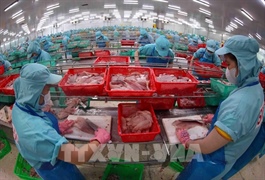Seafood exporters look to mitigate risks
Seafood exporters look to mitigate risks
More than 400 Vietnamese seafood exporters and those planning to enter the US market with high-value shipments could face potential disruptions to their operations following the imposition of retaliatory tariffs.
The seafood sector, currently Vietnam’s sixth-largest export industry to the US, is seeking solutions to mitigate the impact of the US policy to implement a blanket 10 per cent import tariff on Vietnamese goods into the States.
Le Hang, deputy general secretary of the Vietnam Association of Seafood Exporters and Producers (VASEP), warned in early April that around 25,000 tonnes of seafood scheduled for export to the US between April and May, along with some 29,500 tonnes already under contract, will be directly impacted by the newly imposed tariff.
She cited the example of a $500,000 shrimp shipment that previously faced a 5 per cent tax, or $25,000, would see that tax figure double.
“Vietnamese seafood exports to the US currently enjoy a tax rate of zero or 5.5-7 per cent to anti-dumping duties and will now face an additional 10 per cent reciprocal tax. This means that the tax on Vietnamese seafood entering the US will increase significantly but compared to the previously announced rate of 46 per cent, it is still much lower,” Hang said.
The US is one of Vietnam’s top export markets, not only holding a high market share but also having a significant influence on the seafood industry, according to the Ministry of Agriculture and Environment.
The annual export turnover to this market is around $2 billion, accounting for one-fifth of the total seafood export value, with key products such as shrimp 20 per cent, basa fish 25 per cent, and tuna over 40 per cent.
According to VASEP, more than 400 Vietnamese companies are currently exporting or planning to export seafood to the US, with large and high-value orders. Faced with the prospect of the new countervailing duty, many companies are confused and concerned about the need to renegotiate signed contracts.
Ho Quoc Luc, chairman of the board at Sao Ta Food JSC, one of the top five shrimp exporters in Vietnam, stated that Vietnamese seafood companies often pay the full cost, insurance, and freight before shipping goods to their partners.
“With an import duty of 10 per cent, along with related costs and other taxes such as subsidy taxes and anti-dumping duties, the total tax burden that Vietnamese seafood exporters must bear when exporting goods to the US could reach 40 per cent,” Luc said.
Nguyen Van Dao, CEO of Godaco Seafood JSC in the Mekong Delta province Tien Giang, expressed concern that the new tax would prevent the company from achieving its targets for 2025 and will require a change in its operational strategy.
Godaco, one of the top 10 basa fish exporters in Vietnam, currently owns eight factories and 30 farming zones with a processing capacity of 40,000 tonnes per year. With an export turnover of approximately $100 million in 2024, Godaco aims to maintain this turnover in 2025, with a total export volume of 40,000 tonnes.
“In the context of the new tax causing risks regarding profits, markets, and purchasing power, seafood companies should diversify their markets, enhance their capabilities, and improve product quality to overcome this challenging period,” he noted.
In addition to the US, Godaco Seafood’s main markets include the EU, China, Japan, South Korea, Brazil, the Middle East, and Southeast Asia.
Nguyen Van Kich, chairman of the board at Cafatex Seafood JSC, stated that the US imposition of a 10 per cent reciprocal tariffs means seafood enterprises have three months to process orders signed with partners. However, ramping up production in a short period may lead to domestic seafood raw material prices being pushed up. “The current priority is to fulfill signed orders and retain customers while waiting for a clearer direction,” Kich said.
According to a report by Dragon Securities, the tax deferral means Vietnamese basa fish will benefit greatly, reclaiming market share from tilapia and pollock from the US. The export volume of basa to the US this year could increase by 35 per cent compared to 2024.
In 2024, Vietnam’s seafood export turnover reached $10 billion, primarily focused on major consumer markets such as China, the US, Japan, the EU, and South Korea, according to data from the Ministry of Agriculture and Environment. Vietnam is currently the world’s third-largest seafood exporter, behind only China and Norway.
|
Nguyen Hoai Nam, general secretary Vietnam Association of Seafood Exporters and Producers In the current urgent situation, we hope that the prime minister and relevant ministries will negotiate with the United States to establish a unified timeline for the implementation of new import tariffs. Negotiations to adjust and reduce tariffs to a more appropriate level should be grounded in key realities. Vietnam has not been designated a currency manipulator, according to a report by the US Department of the Treasury. The trade surplus is a result of the global supply chain, in which many American companies are involved with various products and brands. Agricultural and aquatic products are essential consumer goods, so the Vietnamese government suggests that the US government consider tariffs that align with the income of American consumers. In the aquaculture supply chain, Vietnam has been importing 1,000 tonnes of soybeans from the United States with zero import tariff. Therefore, we hope that the Vietnamese government will negotiate with the US government to avoid imposing a 10 per cent tariff on all items. It is necessary to separate the tax rate for each item according to the export goods category sent to the US with the corresponding tariff. Furthermore, the government may consider proactively reducing the import tax to zero for seafood imported from the US, with a particular focus on key products such as shrimp and tuna. In reality, Vietnam’s seafood imports from the US are insignificant, so reducing the import tax to zero can provide a basis for negotiation and requesting the US to apply a corresponding zero import tax similar to what Vietnam applies to the US. |
- 16:03 25/04/2025























